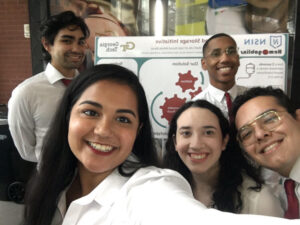According to the American Red Cross, every two seconds someone in the United States needs a blood transfusion. That fails to take into account injuries sustained by troops in war zones or others needing the precious resource in corners of the world that can take days or weeks to reach.
Yet currently, whole blood can only be stored and remain viable for 35 days as hemolysis – or the breakdown of red blood cells caused by acidic wastes created by metabolic processes that whole blood suffers over time.
How, then, can we extend the window of opportunity for this life saving, precious resource?
The Hemogoblins, accepted this challenge in their Fall 2021 Georgia Tech BME Capstone project under the direction and guidance of key advisors Captain Charles Hutchinson, MD, Battalion Surgeon, 3D/75th Ranger Regiment, United States Army and Patrick Reynolds, PhD, University Program Director for the National Security Innovation Network.
The result of their 16 weeks on the project, a novel blister-in-blood-bag of sufficient design and performance, including durability, to warrant follow on research and development efforts.
“The differentiating factor of the HemoGoblin bag is the introduction of a blister or inner pocket. This inner pocket will contain an additive which, when released by squeezing the pouch, will reduce the acidity of the blood. This will allow for the blood to be stored longer and at a better quality. Testing indicated that the durability of the material was more than sufficient with a less than 5% permanent deformation after over 45 minutes. Also, force testing of the inner pocket indicated that an average force of approximately 1 kilogram is required to administer the additive. Conclusively, the HemoGoblin bag is sufficient to house the additive and 500 mL of whole blood. Future steps would involve determining the exact additive to use and conducting blood testing on whole blood samples.”
GCMI provided the Hemogoblins with the lab space and equipment they needed to assess the biomechanical capability of their design and prototype and to test and advance design elements including the inner pocket or “blister.”
“GCMI and T3 Labs had everything we needed to successfully complete our biomechanical performance testing including centrifuges with which we were not completely familiar, and with which they provided the education and assistance we needed to use them properly,” said Hemogoblins team member Jonathan Delemar, a Georgia Tech Biomedical Engineering major. “Creating a blister designed to burst with a specific amount of force inside of a bag designed to meet stringent durability requirements like a blood bag is not as simple as it sounds. Exactly how does one get a blister to burst without injection molding, for example.”
While Jonathan described the ascorbic acid and bicarbonate testing on shelf life extension was inconclusive, the durability and design testing yielded results positive enough to make next layer additive research and testing a value based prospect.
 We are proud of the work we have done to advance the cause and hope this work is built upon successfully by the next generation of candidates that take it on.”
We are proud of the work we have done to advance the cause and hope this work is built upon successfully by the next generation of candidates that take it on.”
We encourage you to take just three minutes to meet the team and watch their project presentation here.
Team Hemogoblins
- Jonathan Delemar
- Gabriel Astralaga
- Prerana Kumar
- Dane Rubenstein
- Milagro Sanchez
We wish the Hemogoblins all of the best in their future endeavors, be those in industry, academia or other professions. Medtronic and Goldman Sachs are in good hands with Mr. Astralaga and Ms. Sanchez joining those entities respectively. We congratulate the entirety of the Fall 2021 Capstone teams on their work.
GCMI’s mission is to bring new medical technologies to market that improve quality-based outcomes and delivery of care for patients worldwide. This certainly includes supporting development of medical technologies born in our backyard from faculty, researchers and students with whom we share our institutional affiliation.
